how to install backer board
How to Install Cement Board for Tile Projects
The best base for ceramic tile is waterproof cement board.
![]() Time
Time
A full day
![]() Complexity
Complexity
Beginner
![]() Cost
Cost
$51–100
Introduction
Installing cement board correctly is the most critical part of a first-class tiling project. Here's how to do it.
Tools Required
Materials Required
- 2 x 4s
- Cement board
- Cement board screws
- Fiberglass mesh tape
- Thin-set mortar
Step 1: Overview
Move over solid mortar bed, and say hello to cement boards. The traditional method of installing ceramic tile called for setting it in a solid mortar bed. Troweling a perfectly flat bed required great skill, but the reward was a tile job that lasted for decades. Today, most professional tile setters back their tile with cement board instead, because it offers almost the same durability with a lot less work. And the best part? Do-it-yourselfers can use it too.
Cement board is a thin layer of mortar sandwiched between sheets of fiberglass mesh cloth. The 1/2-in. thick board is unaffected by water, making it a great substitute for a mortar bed.
In this article, we'll show you how to create a strong, durable and waterproof tile base around your bathtub using cement board. We chose the tub surround because it's highly leak-prone, and an ideal spot for cement backer board. Although cement board is heavy and a bit awkward to cut, even a novice should be able to complete a professional-quality tub surround, ready to tile, in a day. (Allow half a day to tear out the old tile and perhaps several more days to let damp wood dry out.) Once you are done installing the cement board, here are some bathroom tile trends you'll want to explore.
Figure A: Cement Board Installation Details
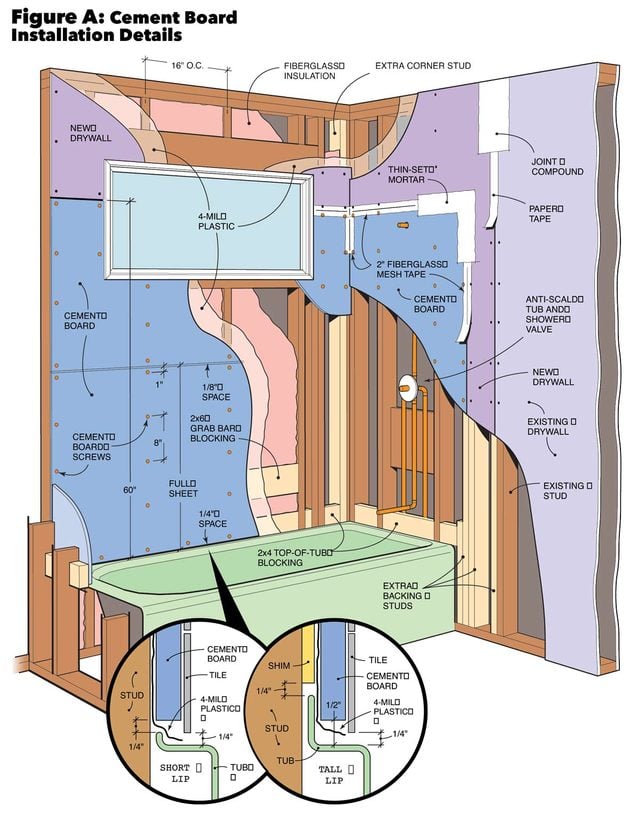 Family Handyman
Family Handyman
Add blocking and other framing details before hanging the cement board.
Project step-by-step (18)
Step 1
Buying materials
Cement board, technically called cementitious backer unit (CBU), is manufactured under different brand names. The standard size sheet is 3 x 5 ft. and 1/2 in. thick, weighs 45 to 60 lbs. and is available at most full-service lumberyards and building supply centers. The 1/2-in. thick cement board spans studs spaced 16 in. on center. Other sizes, like 3 x 4 ft., 3 x 6 ft. and 4 x 4 ft., are available, but you may have to contact a tile supplier to find them. Our project, tiling the walls around a standard 5-ft. tub to a height of 6 ft., requires four 3 x 5-ft. sheets.
To attach the cement board to the studs, you'll need special 1-1/4 in. cement board screws (see Fig. B). These screws have a coating to resist corrosion, a special wide head with cutting flutes and hi-low threads for a strong grip. If you can't find them at a home center, call tile specialty stores. If special screws aren't available, attach the cement board with 1-1/2 in. hot-dipped galvanized roofing nails.
You'll also need a roll of 2-in. wide fiberglass mesh cement board tape and a 25-lb. bag of thin-set adhesive, both available at home centers. For the fiberglass mesh tape be sure to use the special, heavier type sold for use with thin-set mortar, as regular drywall mesh tape will rot. The thin-set is a cement-based powder that you mix with water or latex additive to form a thick paste, which is used to seal the seams in the board and can also be used to set the tile.
Finally, you'll need an 8 x 12-ft. piece of 4-mil plastic sheeting and some straight 2x4s.
Step 2
Check for bowed studs
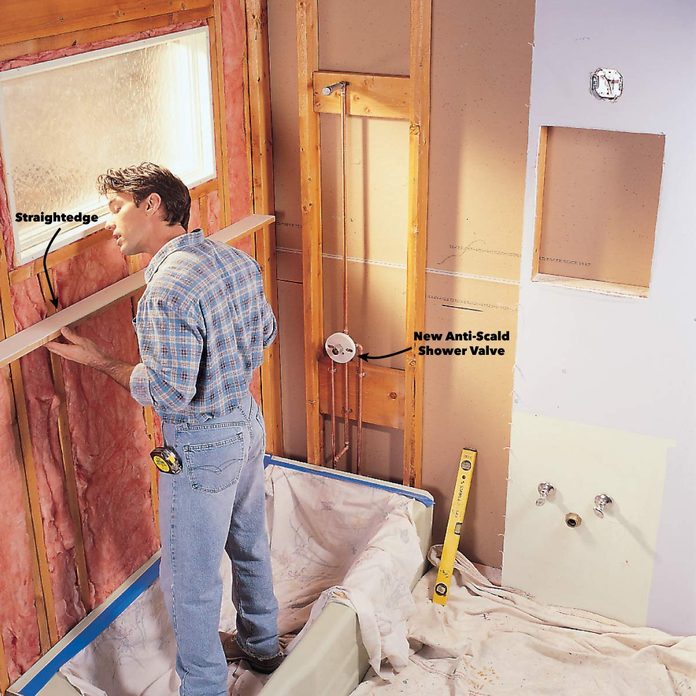
Protect the bathtub with a dropcloth and seal the edges with tape to keep out debris. Tear out the old tile and backing to the bare studs. You'll have to remove the faucet handles, tub spout and shower head.
Now's the time to straighten crooked studs. This is a critical step. Tile is easier to set and looks better on a straight wall. Press a straightedge against the studs. Shim low spots with strips of roofing felt stacked up to the right height or with thin strips of wood. You can also screw or nail a straight stud alongside a crooked one.
Sign Up For Our Newsletter
Complete DIY projects like a pro! Sign up for our newsletter!
Do It Right, Do It Yourself!
![]()
Step 3
Add blocking
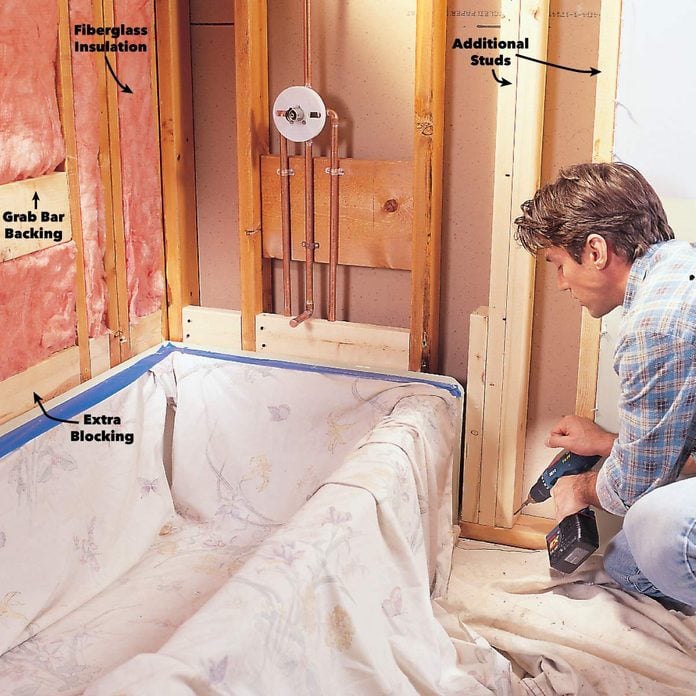
Extra blocking installed now makes it easier to screw in the edges of the cement board later. Screw full-length studs to the framing to support the outside edge of the cement board. Add studs to the inside corners if necessary. The goal is to provide at least 1-1/4 in. of backing at every edge. Screw in blocking at the top edge of the tub to support and strengthen the lower edge of the cement board. Add wood backing where grab bars, shower curtain rods or shower doors will be.
Measure the thickness of the drywall or plaster where the cement board will meet it. If this dimension is more than 1/2 in., add strips of wood to the studs so the cement board will be precisely flush with the old wall.
Step 4
While your walls are open:
- Add wood blocking now where you will be installing towel bars, grab bars or shower doors; then you won't have to rely on those frustrating little plastic anchors to hold up your fixtures.
- Upgrade the insulation on outside walls with new, higher R-value fiberglass batts.
- You can replace your old tub faucet with a new pressure-balancing shower valve.
Step 5
Waterproof the walls
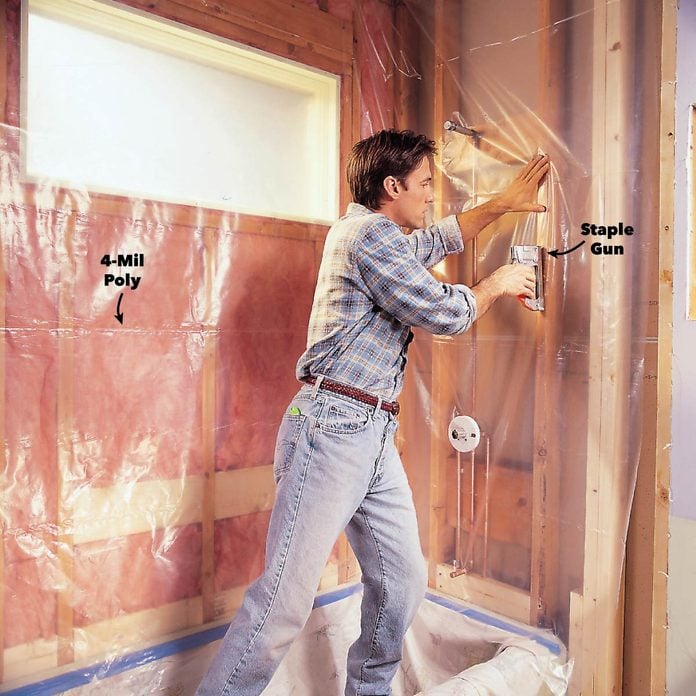
Add the vapor barrier. Staple 4-mil plastic sheeting to the framing. Drape the plastic into the tub and cut it off after the cement board is installed. Use a single piece to avoid seams. Push the plastic tightly into the corners before stapling to avoid creating a bridge of plastic that will tear when you install the cement board.
The plastic serves as a vapor barrier for the insulated wall and as a last defense against any water that may sneak through the tile and cement board.
Step 6
Advice about gaps in cement boards
Hanging cement board is one job where gaps are desirable. Space the bottom sheets 1/4 in. above the tub lip to allow for movement of the tub and floor. Use nails or screws as temporary spacers to create a 1/8-in. gap between sheets of cement board. When you squeeze the thin-set mortar into this gap, it will lock the two sheets together and strengthen the seam. Finally, leave extra clearance around each piece by deducting about 1/4 in. from your measurements before you mark the cement board for cutting. Believe me, you want to avoid the knuckle-skinning task of trimming a little off. Any gaps will be covered with mesh tape and thin-set.
Step 7
Hang the cement boards
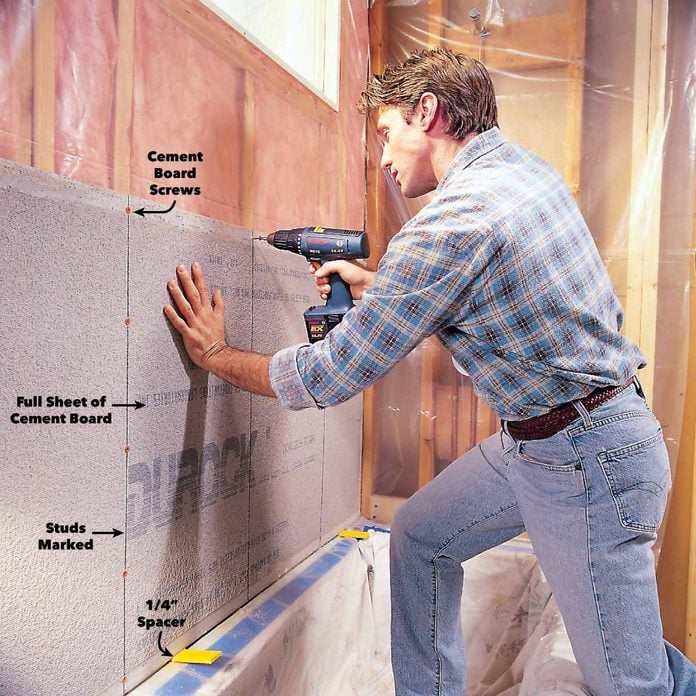
When the prep work is done, start the rewarding job of hanging the cement board. All your hard work will start to pay off as the first sheet goes up.
Screw a full-size 3 x 5-ft. cement board to the back wall. Place special 1-1/4 in. cement board screws every 8 in. along each stud but 1 in. away from edges to avoid breakage. Hold the sheet above the tub shoulder with 1/4-in. spacers. Drive screws flush with the surface of the board, being careful not to break through mesh. Avoid driving them at an angle.
Step 8
Screw the board in place

Keep screws 1 in. away from the edges.
Cement board has a smooth side and a rough side. Face the rough side out if you will be using thin-set mortar adhesive to install the tile but the smooth side out if you will be using latex mastic.
Step 9
How to cut cement board: Score

Mark the next sheet for cutting. Clamp a straightedge along the cutting line, and use it as a guide to score the cement board with a utility knife. Score the full length of the sheet about five or six times using firm downward pressure.
You'll ruin a couple of knife blades while cutting, so keep some extras handy.
Step 10
Snap

Snap the board along the scored line by laying it over the edge of your work surface and pressing down. Hold the broken-off piece while you cut through the fiberglass mat on the back.
Step 11
Remove
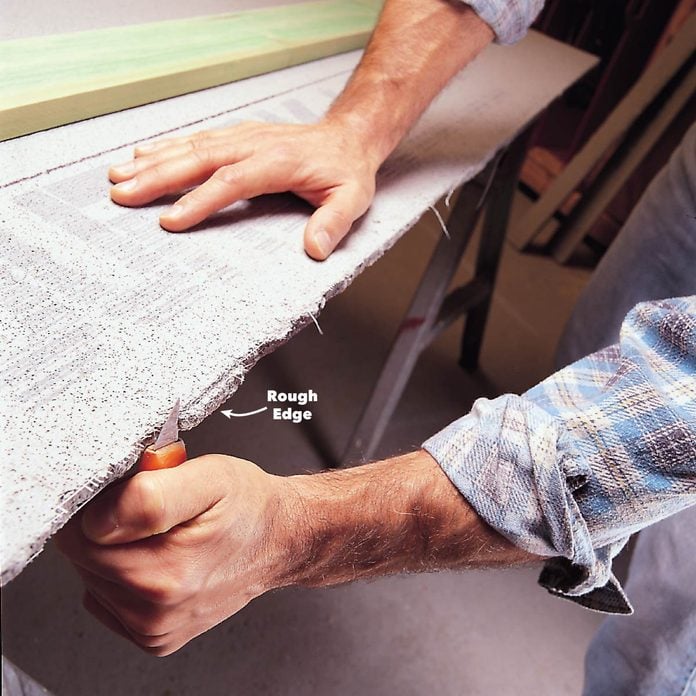
Remove bumps and rough edges with a utility knife or a wood rasp with a replaceable blade.
Step 12
Use a jigsaw to cut shapes
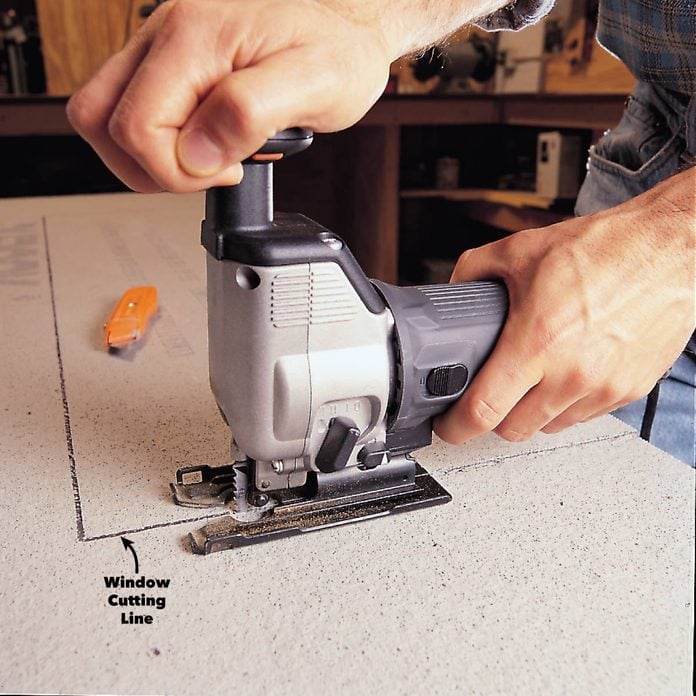
Saw the two sides of the window notch using a jigsaw. Then score and break out the remainder using the procedures we showed in step 9.
Use carbide grit jigsaw blades to cut cement board. You can also use regular blades, though they'll wear out after a few cuts.
Step 13
Find centers for plumbing fixtures

Measure out from the back wall and up from the tub shoulder (plus the 1/4-in. spacer) to find the centers of the valve, spout and shower head. Make a sketch of the wall showing the dimensions and hole sizes. Add 1/2 in. to the hole diameters for an easier fit.
Step 14
Drill small holes
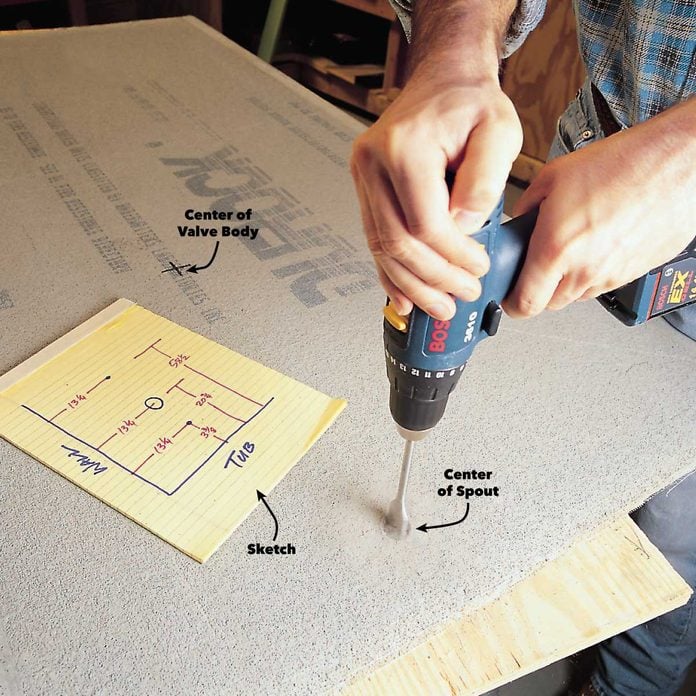
Mark the hole centers on the cement board. Drill holes smaller than 1-1/2 in. with an old spade bit or a carbide-grit hole saw.
Step 15
Punch out large holes
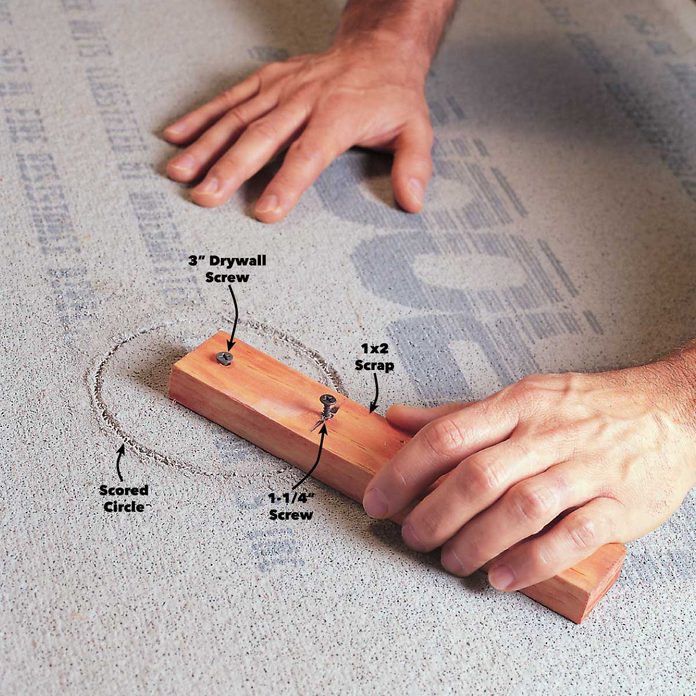
Construct a homemade circle cutter for larger holes. Drill a small hole in one end of a scrap of wood, attach it to the cement board at the center of the circle, screwing through the cement board into the work surface below. Then screw in a "cutter" screw where you want the circle to be scored, for example, 2 in. from the center for a 4-in. hole. Allow the point to stick out the bottom. Spin the cutter while applying pressure to score a perfect circle. Repeat the process on the other side. As shown in the inset photo, pound out the circle with your hammer. Be careful not to damage the edge of the hole.
Step 16
Finishing up: Set the sheet on spacers
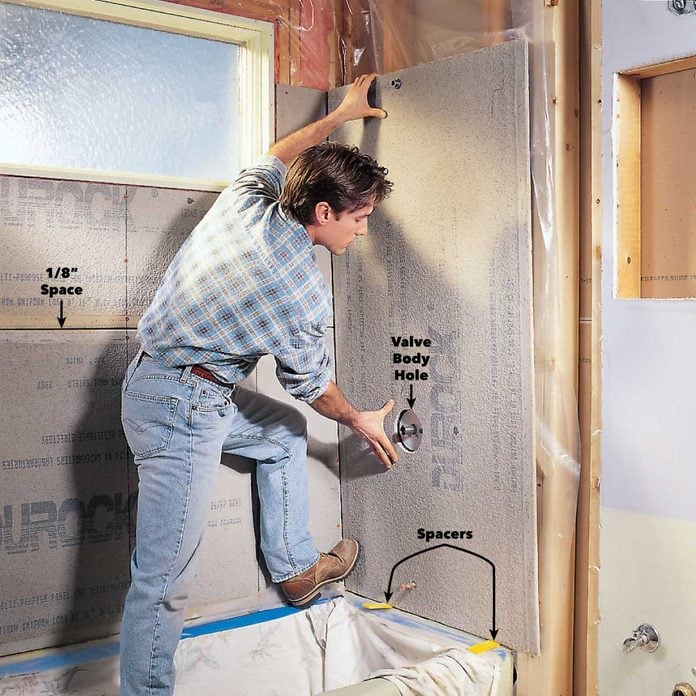
Set the completed sheet in place, spacing it above the tub shoulder with 1/4-in. shims, and screw it in. Complete the opposite wall and the small pieces next to the tub.
Step 17
Use special mesh tape on seams

Complete the job by piecing in any missing drywall and taping the seams. Cut drywall to fill in between the existing wall or ceiling and the cement board. Screw the drywall to the studs. Cover all of the corners, joints and seams, including the joint where drywall and cement board meet, with the fiberglass mesh tape.
Step 18
Tape the seams with mortar

Following the manufacturer's recommendations, mix the thin-set mortar adhesive with enough water to form a thick paste. Wear a NIOSH-approved dust mask when mixing the powder. Spread the thin-set over the tape.
Cover the tape with a skim coat of thin-set mortar, squeezing it through the tape to fill voids and cracks. Remove any excess material before it hardens.
When you're done covering the tape with thin-set, you're ready to tile. You don't even have to let the thin-set dry. Don't worry if the tile doesn't cover the joint between the cement board and the drywall. Just finish it with a setting-type joint compound, which comes in 25-lb. bags of powder that you mix with water. (It's available at home centers.) Setting-type compound is stronger and more water-resistant than the type that hardens by drying. Here are 13 tips to keep in mind when choosing bathroom tile.
how to install backer board
Source: https://www.familyhandyman.com/project/cement-board-ceramic-tile/
Posted by: carrollboremat.blogspot.com

0 Response to "how to install backer board"
Post a Comment